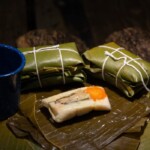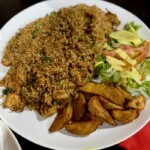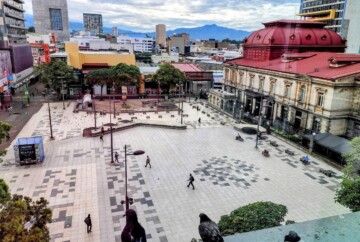Fresh ingredients, simple recipes, colorful fruits, and bold flavors: this is what characterizes most foods in Costa Rica. Without a doubt, exploring the country’s cuisine is a must when visiting this tropical paradise.
Personally, I love this part of traveling because food has this incredible ability to unite people from all walks of life. It’s like a window into the local identity and heritage. When we landed in San José, we jumped right into the food scene by joining this food-tasting tour, and it completely immersed us in Costa Rican culinary traditions.
Costa Rican food reflects a fascinating fusion of three distinct cultures. Before the arrival of Europeans, the indigenous people cultivated staples like corn and beans, which were the backbone of their diet. With the Spanish colonization in the 16th century, new ingredients like rice, pork, and spices were introduced. But the story doesn’t end there—the Spaniards brought enslaved Africans, whose cooking traditions also became woven into the culinary tapestry of Costa Rica.
Now, allow me to take you through some of the most iconic dishes Costa Rica has to offer. Before we dive in, here’s a tip: while you’ll find fantastic restaurants in Costa Rica, make sure to eat at a soda. These are small, family-run diners that offer homemade meals at affordable prices. This is where you’ll get real, local flavors and the chance to socialize with people.
1. Gallo pinto, the national food of Costa Rica
When it comes to the main Costa Rican dishes, gallo pinto is the star of the show. This iconic dish isn’t just food; it’s part of Costa Rica’s cultural identity. This ultimate breakfast staple is a hearty mix of rice and beans cooked with onions, peppers, and cilantro.
Gallo pinto is traditionally served with eggs (scrambled or fried), minced meat, ripe plantains, and warm tortillas. Some places go the extra mile, adding cheese or a slice of fruit to the plate. And, of course, breakfast wouldn’t be complete without freshly squeezed orange juice and a cup of Costa Rica’s legendary coffee. It’s a breakfast designed to fuel your day with flavor and energy.

1. Gallo pinto, the national food of Costa Rica
If you’re heading to the Caribbean coast, you’ll find a regional twist on gallo pinto, and trust me, it’s worth the wait. I’ll get to that version later—it’s just as tasty but has its own unique flair.
A quick heads-up: gallos are not the same as gallo pinto. Gallos refer to corn tortillas (similar to tacos) that are often topped with minced meat, cheese, or sausage. They’re a staple appetizer in Costa Rican cuisine and perfect for a quick bite.
2. Casado, a traditional lunch food in Costa Rica
Next up on the list of must-try dishes is casado (which literally translates to “married”), one of the most famous foods in Costa Rica. You’ll find casado everywhere, from fancy restaurants to simple roadside diners or sodas. It’s a hearty, balanced meal that’s easy to enjoy no matter where you are.
Now, you might be wondering about the origin of its name. There are a couple of theories: one suggests that the different ingredients are “married” together on the plate, with rice at the center. Another story goes that workers eating a casado during long days away from home felt like they were being cared for by their wives.

2. Casado, a traditional lunch food in Costa Rica
Whatever the origin, one thing is for sure—this dish is a complete meal packed with nutrients and flavor. The foundation is rice, typically served with beans, a choice of protein—chicken, pork, or beef—and accompanied by a fresh salad and potatoes. Some versions also include fried plantains, adding a subtle sweetness that balances the savory flavors.
3. Chifrijo, one of the most common modern dishes in Costa Rica
Unlike the traditional dishes rooted in history, chifrijo is a relatively modern creation. The name itself is a clever mashup of its two main ingredients: chicharrón (fried pork) and frijoles (beans). This dish first appeared in bars and restaurants and has quickly become a favorite starter on every typical Costa Rican food menu.

3. Chifrijo, one of the most common modern dishes in Costa Rica
Chifrijo combines rice, beans, crispy pork, tomato, onion, and chimichurri in a deliciously layered bowl. It’s usually topped with fresh pico de gallo, avocado, and crispy plantain chips, creating a mix of textures and flavors that’s impossible to resist.
No matter where you are in Costa Rica, there’s always a good time to enjoy chifrijo. It’s a social dish that brings people together and starts a lively conversation or a casual gathering.
4. Olla de carne, one of the most classic lunch foods in Costa Rican cuisine
One dish you absolutely cannot miss while in Costa Rica is olla de carne, or beef stew. If you’re someone with a big appetite, this hearty stew is a great choice to keep you full and satisfied; plus, it’s packed with incredible flavors that will melt in your mouth.

4. Olla de carne, one of the most classic lunch foods in Costa Rican cuisine
This delicious soup has an array of ingredients, starting with beef cut into large, tender chunks. Then, a mix of vegetables is added, including yuca, chayote, corn, green plantain, carrots, tiquizque (a type of taro), potatoes, and ñampí (a root vegetable native to Costa Rica). Everything is slow-cooked over low heat for hours, allowing the flavors to meld together into a rich, satisfying broth.
The origin of olla de carne goes way back to colonial times, and it was often enjoyed during weekends when families would gather around the table. This dish is a great way to experience a variety of vegetables and enjoy a nutritious, comforting meal that truly represents the heart of Costa Rican cuisine.
5. Picadillo de papa, a must-try traditional food in Costa Rica
Another Costa Rican food you won’t want to skip is picadillo de papa (potato hash). Potatoes are a culinary staple across Latin America, but in Costa Rica, they shine in this humble yet mouthwatering dish.

5. Picadillo de papa, a must-try traditional food in Costa Rica
At its core, picadillo de papa is a mixture of diced potatoes cooked with minced meat and other vegetables. The beauty of this dish is that depending on who’s cooking, you can find variations that include whatever ingredients are on hand.
What makes this dish uniquely Costa Rican is the addition of local spices like garlic, cilantro, pepper, and achiote, which infuse the potatoes and meat with vibrant, bold flavors. It’s typically served with rice and beans, so it’s a hearty, well-rounded meal that you cannot miss!
6. Arroz con siempre, one of the most delicious holiday foods in Costa Rica
Arroz con siempre (roughly translated to “rice with always”) is one of the funniest food names in Costa Rica, but it perfectly represents the family tradition. In reality, it’s just rice with chicken, but the Ticos have given it this affectionate nickname because it’s a dish that always seems to be present at family gatherings. If you’re lucky enough to join a local family for dinner, chances are this dish will be on the table.

6. Arroz con siempre, one of the most delicious holiday foods in Costa Rica
This simple yet flavorful dish is made with rice, chicken, and veggies like carrots, peas, and sometimes corn. The star ingredient is fresh cilantro, which gives it that unique and vibrant flavor. As a dish that’s passed down through families, each household has its own spin on it, often adapting the ingredients to suit the preferences of everyone at the table for their Sunday traditions. Arroz con siempre is more than food—it’s a taste of Costa Rican tradition!
7. Tamales, one of the typical Christmas dishes of Costa Rica
Tamales hold a special place in Costa Rican food culture, especially during the Christmas season. While you can find tamales at various celebrations year-round, they require plenty of time and effort to make, which is why they’re typically reserved for special occasions.

7. Tamales, one of the typical Christmas dishes of Costa Rica
The origins of tamales go back to indigenous Costa Rican traditions, and they’re made from dough that’s typically crafted from corn, rice, or plantains. The filling usually consists of pork, corn, rice with achiote, carrots, green beans, chickpeas, peas, and cilantro, though variations can exist depending on the cook.
During Holy Week, many opt for a version filled with beans and corn. Once assembled, the tamales are wrapped in plantain leaves and boiled for a few minutes.
8. Sopa negra, a specialty of southern Costa Rican cuisine
When picturing Costa Rica, you probably think of sunny beaches and tropical weather. But some regions experience cooler temperatures, and the locals have developed a set of comforting dishes to keep themselves warm. One of the most beloved Costa Rican dishes in such climates is sopa negra, or black bean soup.

8. Sopa negra, a specialty of southern Costa Rican cuisine
This soup is made with black beans, onion, garlic, cilantro, cumin, and tomato paste. It’s typically served with hard-boiled eggs, a side of rice, and warm corn tortillas. If you’re feeling under the weather, locals swear by sopa negra as a healing dish that will work like a magic potion to get you back on your feet.
9. Arroz con leche, a traditional dessert you must eat in Costa Rica
Costa Rican cuisine isn’t just about savory dishes; there are plenty of sweet treats to enjoy as well, and arroz con leche (rice pudding) is a popular dessert you’ll find in many Costa Rican homes.
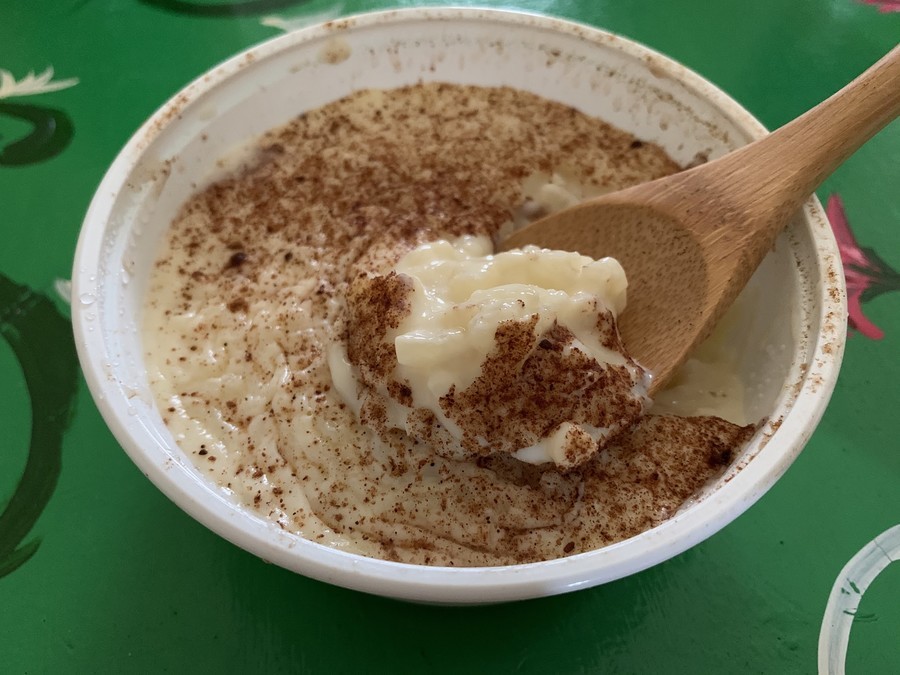
9. Arroz con leche, a traditional dessert you must eat in Costa Rica
This creamy dessert may look simple, but its flavor is rich and comforting. It is made from rice, milk, sugar, and cinnamon, and it has a smooth, velvety texture that’s hard to resist. While it might remind you of Spanish arroz con leche, the Costa Rican version has its own twist—typically skipping the lemon peel but sometimes including condensed milk or even fruit, depending on the cook.
You can enjoy it either hot or cold, but no matter how you like it, the creamy consistency and warm spices will make it an excellent addition to most Costa Rican dishes.
10. Rondón, a must-try fish dish from Costa Rica’s Caribbean coast
Rondón is one of the most common foods in Costa Rica, especially in the Caribbean region. If you’re visiting the beautiful Costa Rican beaches in the Limón region and want to try some Afro-Caribbean flavors, rondón is your best bet.

10. Rondón, a must-try fish dish from Costa Rica’s Caribbean coast
This dish is a hearty seafood or fish soup with a creamy coconut milk base that gives it a spectacular richness. It’s packed with an array of ingredients, including green plantains, potatoes, yuca, sweet peppers, carrots, and a blend of spices. Cilantro, which is a key ingredient in Costa Rican cuisine, is also added to the dish.
The beauty of rondón is that it’s a bit different every time, depending on the fresh catch of the day.
11. Rice and beans, the heart of most Costa Rican meals
As I mentioned earlier, the Caribbean region has its own signature take on a classic breakfast dish: rice and beans. While it’s one of the most common breakfast foods in Costa Rica, you can enjoy it at any time of the day—and trust me, I did! It quickly became one of my absolute favorites, and I couldn’t resist having it all the time!

11. Rice and beans, the heart of most Costa Rican meals
The rice and beans are cooked in coconut milk, giving them a rich, creamy texture and a hint of sweetness that pairs perfectly with savory dishes. Typically, this dish is served with a piece of chicken — but not just any chicken. The meat is marinated and cooked in a special Caribbean sauce. It’s usually accompanied by a side of fresh salad and crispy patacones, making for a satisfying, flavorful meal.
12. Plátano maduro con queso, another common food in Costa Rica
Plátano maduro con queso, or ripe plantain with cheese, is proof that sweet and savory can live in perfect harmony. You’ll see it served as a side dish, but it’s also sweet enough to be enjoyed as a dessert. Either way, it’s an absolute must-try.

12. Plátano maduro con queso, another common food in Costa Rica
This is one of the simplest and quickest Costa Rican foods you can prepare: ripe plantains are peeled, sliced, and fried until golden brown. Then, cheese—usually queso fresco or mozzarella—is added on top, which melts instantly from the heat of the plantain.
If you’re tempted to try making this at home, the trick is to fry the plantains until they’re crispy on the outside while keeping the inside soft and tender. And don’t forget to use very ripe plantains with black spots on the peel for the best flavor.
13. Tres leches, another classic sweet Costa Rican dish
If you have a sweet tooth, tres leches cake (“three milks cake”) is one of the top desserts in Costa Rican cuisine. It’s not only popular in the country but across much of Latin America.

13. Tres leches, another classic sweet Costa Rican dish
This decadent dessert gets its name from the way it’s made: the cake is soaked in a combination of three kinds of milks: evaporated milk, condensed milk, and cream, which gives it a soft, moist, and ultra-rich texture. To make it even better, it’s topped with a layer of fluffy meringue, making it incredibly rich and indulgent (not the best pick if you’re easily overwhelmed by sweetness!).
I personally love it and even tried making it at home, but it never turns out quite like the ones from Costa Rican bakeries. Sometimes, you’ll also find variations of tres leches with added fruits, coconut, or even more cream—each one as delicious as the last.
14. Patacones, one of the typical fried foods of Costa Rica
Patacones are another exquisite local food in Costa Rica that you simply have to try. Green plantains are a staple in this country, and while they’re used in many dishes, patacones are one of the most popular and versatile options. They’re the perfect snack to satisfy midday cravings or even an excellent appetizer.

14. Patacones, one of the typical fried foods of Costa Rica
These thick slices of green plantain are fried twice to achieve their signature texture—crispy on the outside, yet soft and tender on the inside. They’re served with delicious toppings like refried beans, guacamole, or fresh queso fresco, creating a blend of flavors that’s impossible to resist.
The cooking process is unique, too: the plantains are fried once to soften them, then smashed flat with a heavy object before being fried again until golden and crisp. It’s a bit of a process, but trust me, the effort is well worth it!
15. Ceviche, another traditional food in Costa Rica you must try
If you’re exploring the beaches of Tamarindo or other stunning beaches in Guanacaste, you’ll quickly stumble upon an old favorite that feels right at home here. You might usually associate this dish with another Latin American country, but it has firmly earned its place on the list of best Costa Rican foods.

15. Ceviche, another traditional food in Costa Rica you must try
Ceviche, often linked to Peruvian culinary traditions, is a common dish in Costa Rica as well. The Costa Rican version is typically made with fresh, raw white fish and, of course, a whole lot of lemon. It’s mixed with onions, peppers, and cilantro to create a refreshing burst of flavors.
Making ceviche is almost like an art form. The fish needs to be impeccably fresh, and the seasoning has to hit just the right balance. Too little lime and the fish won’t soften properly; too much, and the flavor might overpower the fish. And let’s not forget that working with raw fish means you need to handle it with care. Ever tried whipping it up yourself? The Costa Rican version is definitely worth a try!
16. Patí, a must-try Caribbean dish in Costa Rica
Costa Rica’s Caribbean coast isn’t just about stunning beaches and vibrant wildlife; it’s also home to some seriously tasty dishes with a rich history. If you’re heading to Puerto Viejo, Cahuita, or Manzanillo, you can’t leave without trying patí, one of the most famous dishes in the region—and an essential part of the local culture.
To understand the origins of this dish, we need to go back to Jamaica. There, English pastries mixed with African culinary influences to give birth to the patí. The original patís became popular because they were cheap, easy to make, and incredibly delicious.

16. Patí, a must-try Caribbean dish in Costa Rica
Over time, this humble pastry traveled across the Caribbean and became a staple street food in Costa Rica. Many families began cooking them at home and selling them to make a living. Back then, patís were often stuffed with simple fillings like potatoes, chili, and a sprinkle of sugar.
Today’s version has leveled up! Modern patís are typically filled with flavorful meats, though you’ll also find versions featuring seafood or fish. What makes them truly irresistible is their bold seasoning—a mix of spices and hot peppers that gives them an intense kick. Trust me, it’s almost impossible to stop at just one.
17. Chorreadas, a simple yet delicious food in Costa Rica
Chorreadas are proof that simplicity often leads to the best flavors. These sweet or savory corn pancakes are one of the most beloved traditional dishes in Costa Rica —and for good reason. How can something so basic taste so amazing?
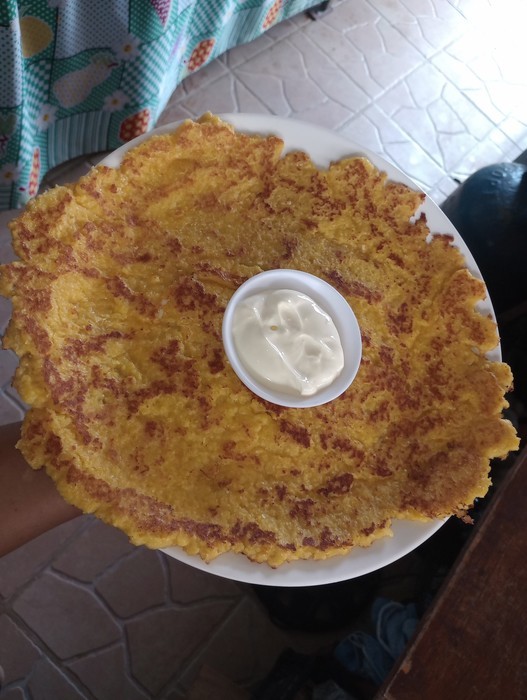
17. Chorreadas, a simple yet delicious food in Costa Rica
The roots of chorreadas go back over 300 years when Indigenous communities first cultivated corn and used it as the foundation for countless recipes. The magic of this dish lies in its humble ingredients: tender corn, flour, milk, eggs, and sugar. Everything is mixed into a batter and cooked on a comal, which is a special clay or ceramic griddle. In fact, the dish gets its name from the batter’s tendency to “drip” (chorrear) onto the comal during cooking.
Chorreadas are usually served with a sweet topping like custard, honey, or syrup, but there’s also a savory version that replaces the sugar with grated cheese. For an even heartier meal, they can be paired with bacon, sausages, or cream cheese.
18. Chan, an ancient Costa Rican drink
Chan isn’t exactly a dish, but it’s one of Costa Rica’s most traditional and refreshing drinks, made from the seeds of the chan plant. If those seeds look familiar, it’s because they’re now widely known as chia seeds, celebrated worldwide as a superfood. But here, they’ve been part of local food culture in Costa Rica for generations.

18. Chan, an ancient Costa Rican drink
Making chan is incredibly simple: you just add water to the seeds and let them hydrate. As the seeds soak, they release their nutrients and form a slightly gelatinous texture, giving the drink a thicker consistency. It’s not only healthy but also surprisingly satisfying.
This drink traces back to Costa Rica’s indigenous communities, who valued chan seeds for their nutritional benefits. Unfortunately, when the Spanish colonized the region, they associated the drink with pagan rituals and forced locals to abandon it.
19. Salsa lizano, the secret sauce of all traditional foods in Costa Rica
If there’s one condiment that defines every famous food in Costa Rica, it’s salsa lizano. This sauce is so ingrained in the country’s culinary traditions that many locals won’t even consider a dish truly Costa Rican without it. In fact, it’s so beloved that many Costa Ricans take a bottle of salsa lizano with them when they travel abroad just to keep a taste of home close by.
The flavor of salsa lizano is unlike anything you’ve ever tried—it’s a perfect balance of sweet and sour with a rich, brown color that looks almost like coffee. It goes well with just about anything, and I have to say, I was a bit skeptical until I tried it myself. You can even pour it over fruits like mango or apple.

19. Salsa lizano, the secret sauce of all traditional foods in Costa Rica
While the exact recipe is a secret, we know that salsa lizano is made from a mix of spices and vegetables like carrots, chili, cucumber, cauliflower, dry mustard, celery, turmeric, and molasses.
The history of this iconic sauce dates back to 1920, when the owner of a small bar in Alajuela wanted to create something unique to set his place apart from others in the area. The sauce became so popular that it was eventually bottled and sold commercially, with a financier named Lizano backing the project—hence the name we all know today.
20. Coffee, the emblem of Costa Rican gastronomy
We can’t talk about the history of Costa Rican foods and drinks without mentioning coffee, a national treasure and one of the country’s most celebrated exports. Not only is it a key economic driver, but coffee is also deeply ingrained in Costa Rica’s culture and daily life.
Coffee first arrived in Costa Rica at the end of the 18th century when it was brought back from Jamaica by a forward-thinking governor. Its cultivation spread very rapidly, and before long, coffee became one of the country’s top exports. The government invested heavily in infrastructure, building extensive railways to transport the beans, which helped Costa Rican coffee gain a reputation for exceptional quality.

20. Coffee, the emblem of Costa Rican gastronomy
Today, Costa Rican coffee is considered some of the best in the world. Thanks to its unique flavor profiles and high production standards, it remains a cornerstone of the country’s economy, making Costa Rica one of the largest coffee producers in Latin America.
Beyond that, coffee is deeply woven into the fabric of Costa Rican life. Here, coffee-making traditions are celebrated, and the most common way to brew it is through the “chorreado” method—pouring hot water over coffee grounds in a cloth strainer.
But if you’re not a coffee fan, don’t worry! You can enjoy its equally delicious cousin, chocolate. There are numerous chocolate tours in Costa Rica, which allow you to learn all about the country’s ancient cacao traditions, sample rich chocolates, and even try your hand at making your own treats.
Best food tours in Costa Rica
Costa Rica’s culinary scene is as diverse and vibrant as the country itself. Exploring the history and flavors behind its dishes is one of the best ways to connect with the local culture. And what better way to do that than with a food tour?
Food tours in Costa Rica aren’t just about eating—they’re full experiences that involve tastings, market visits, and even cooking lessons, all while your guide shares fascinating stories and tidbits about the food and its origins. We joined this gastronomy tour in San José, and it was such a fun way to immerse ourselves in the city’s culinary culture and explore the most famous neighborhoods, like Escalante, Amón, and Otoya.
Along the way, we got to try three traditional dishes at different stops. The grand finale was a café where we sipped on authentic Costa Rican cacao. What made the tour extra special was the guide’s focus on contrasting traditional and modern cuisine. One stop was a rustic spot serving food baked in a wood oven, while the next was a sleek, contemporary eatery. To wrap things up, we tried a delicious liquor-infused ice cream, which was the perfect dessert to end the tour.
This is definitely one of the best excursions in Costa Rica, but if you’re looking for something a bit more refined, you can opt for this tour in Quepos that includes hands-on cooking classes.

Best food tours in Costa Rica
If you’re a chocolate lover, don’t miss the chance to visit one of Costa Rica’s cacao farms, which produces some of the finest cocoa beans in the world. We took this tour in La Fortuna, and it was such a fun (and tasty!) experience. If you’re heading there, I can’t recommend it enough.
That’s all from me for now! I hope this inspires you to dive into the common foods of Costa Rica during your trip. If you’ve got any questions or need tips, don’t hesitate to drop me a comment below—I’d love to help.
And if you’ve already explored the food scene here and think there’s a dish that absolutely deserves a spot on this list of the best foods in Costa Rica, let me know.
Pura Vida!
















